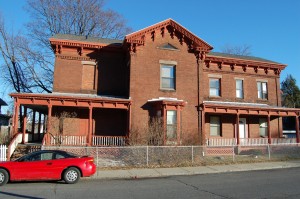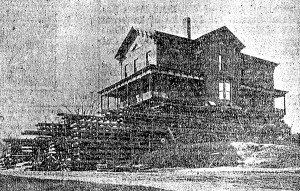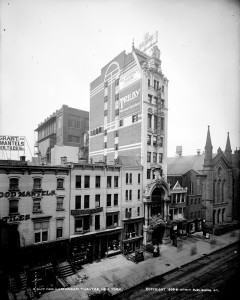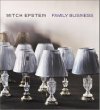by Laurel | February 2nd, 2012
02 February 1925
Louis A. Turgeon of Holyoke Started Moving Business in 1883 and Has Been Moving ever Since — Takes a Man 10 to 12 Years to become Efficient Mover — Took Four Months to Move New York Church
Holyoke, Jan. 31—If at any time it is desired to move the Springfield Auditorium to the river bank or the Holyoke city hall to the Highlands; or the county courthouse to Holyoke it can be done. There is a firm in Holyoke that will cheerfully undertake the task. It has boon their business for 42 years, the moving of all kinds of buildings to all kinds of distances, whirling them around to face different angles, raising them up or letting them down as the desires of the owners,dictate. Louis A. Turgeon of Holyoke started this building movement, so to speak, in 1883 and has been at it ever since, though most of the active work is now carried on by his sons, Louis, Jr., Peter, Fred, Henry, John and Ernest. Each has served a long apprenticeship and each can take charge of the delicate problem of removing a building from one spot and setting it down in another without jar or fret.
All over the Connecticut valley the matter of moving buildings is so thoroughly associated with the Turgeon firm that the name conjures up the picture to the mind of building removal and the removal of buildings suggests the Turgeons. They are masters of the job and have no competitors about here. In every state in New England, in Now York state and states farther away they have operated with success. And it is no simple task to pick up a stone church weighing 8800 tons, move it 200 feet and let it down upon another foundation without disturbing any part of it, not even the big tower. That was one of their feats in Long Island.
Ten Years to Learn the Job
Very often they have eight or 10 jobs going on at the same, time. It takes at least 10 and sometimes 12 years to break in a man so that he will be first class and dependable at this job. In a way It Is as delicate as watchmaking, especially when brick and stone buildings are moved. There are regularly about 25 men in the employ of the Turgeons and even after 10 years’ experience they often fail to qualify far executive positions. For as one of the Turgeon boys explained, the moving; of buildings is wholly different from the construction of them. In the construction of them you have plans, specifications, blueprints and precedents to go by. But you can’t get or make or have any plans and blueprints for the moving of a building. Each building to be moved is a problem in itself; and while the Turgeon boys from long experience can size up pretty quickly just what has to be done and how, regarding the moving of any particular building, it is a sort of “catch as catch can” job. Things come up unexpectedly making a change in operations suddenly necessary or necessitating a delay from some unexpected obstacle. That is why the personal supervision of one of the Turgeons is necessary and why
one of them is on each job most of the time that it is in operation. Even the most experienced of their men will run across a problem once in a while that is too much for him to handle and he has to take it to the executive head.
- George C. Ewing of Holyoke Will Soon Be “At Home” in New Location, 15 feet Lower and Facing Around. View Shows Crib Work Used in These Jobs.
As this is written the old George C. Ewing house, which is being moved from the Holy Cross grounds across the road is high up on a trestle work or cribbing 15 feet above the roadway and blocking it. If their usual success attains, it will be turned, part way around, facing in another direction, and be let down that 15 foot or so, coming to rest on its new foundation without a crack in the structure or a brick working loose. It is slow work of course; and like other similar jobs is attracting a lot of attention from those who pass by curious to see this two-story affair high up on the cribbing.
“What is your way of tackling a job of this sort?” was asked one or the Turgeons.
“Well, as I told you,” he answered, “we -have no plans or specifications to go by. We first, give the building a thorough examination, find out how its timbers lie, and its general construction. Then, if’ it. Is a brick or stone building. we find where we can knock holes in the walls for the steel beams or timbers to support it while it is being moved. I should say that the most important part of the building moving problem is to keep the building at all times perfectly level—all of it everywhere. To do this requires constant inspection and care. If a building is lower In one part than another even by the small part of an inch the walls and ceilings; are subject to strain; a crack is likely to result, and it does not take much of a crack in a brick building to start trouble.
“The next thing we do in to block, up the building and raise it very slowly to get it on the timbers along which it must be rolled. As the utmost care must be taken to keep the building level we have, to make allowances for the settling of the ‘cribs’ on which rest the timbers over which the building moves.”
“In the case of the Ewing building the cribs of 15 feet or so will sink about two inches and we make allowances for that. We use very hard rollers so that there will bo little or no give to them—wooden roller’s of pepperidge wood by preference. The actual moving is done in several ways, but generally by use of drums operated by man power in the’ more delicate jobs, otherwise, horses.
The moving of the First Presbyterian Church at Elmhurst, L.I. the Turgeons consider their masterpiece. No one in New York and its environs wanted to tackle it. To make room for a new boulevard, it was necessary that the church should be moved back 190 feet and raised four feet without disturbing a stone. Moreover, it was made a part of the contract that the stained glass windows, which were imported from England 167 years, ago, and were of great value should be first taken out. But when it came to taking them out it was found that they were so deeply embedded in the stone, built into it in fact, that it would about wreck the sides and ends of the church to take them out. But the Turgeons were game. They’ said they would move the church, windows and all.
They were required to give a bond of $150,000 and told to go ahead. Extra care was taken on this job. The land over which the cribbing was placed on which the church was moved was carefully tested foot by foot. The big tower was braced and careful estimates made as to the excessive weight of this compared with the main body of the church. It was figured that the cribbing and land under the tower would sink two inches more than the rest of it and such allowance was made throughout the work, “It was no guessing contest,” said, one at the Turgeons speaking of the work. “Everything, was carefully worked out. Our experience in moving buildings of all sizes and weights came to our aid. We had no fear of the result. And the building, which weighed 2800 tons was moved to its new location, raised four feet, set on its new foundation without a crack anywhere. For this job they charged $35000 with something like $10,000 for extras. Some of the figuring was done in the hundredths of an inch.
This job took about four months and about $35,o00 worth of apparatus was used on it. About 450 jackscrews were used in lifting up the building, The hauling was done by drums operated by man power, this allowing for the greatest flexibility.
The moving of buildings is not without Its amusing experience. The manse of the Presbyterian church at Elmhurst, L. I., was moved. also, though not so , far, but the land slanted so that after it had gone a little way the rear veranda was several feet higher from the ground than previously. The pastor, with all the dignity possible, walked out while the moving was going on and unconscious of the change started to go down where the back steps had been. The shouts of the workmen warned him and his blank look of astonishment as he saw what had happened was worth going miles to see. “Bless my soul,” he exclaimed, “I didn’t know they had even begun!”
When the approaches to the Memorial bridge in Springfield were being laid, one one-family building had to be moved back a few feet. The woman who lived there was very anxious to be informed when the moving would take place so she could get out. Either accidentally or on purpose she was not notified; and she came to the front door after the change had been made and wither her eyes almost popping out, cried, “Good Lord, when did you do it!”
When the approaches to the Queensboro bridge were being prepared there were a large number of buildings to be moved and a contest arose over the moving. It was announced that the one who moved a building the quickest would get another job. The Turgeons did a fast job and moved the building of one man quite a distance, including turning around a corner of two in the time from morning until night. When night came, the man who lived there came to his home — to what was his home. There was nothing there but the cellar. He scratched his head and asked where his home had gone. No one seemed to know. He started for the city hall to find where it had gone and on the way ran into his house in its new location.
“How did you come to find us?” asked his wife.
I was on my way to city hall and found you by accident,” was the answer.
The Turgeons met with much success and moved scores of buildings which led to business in Long Island City and other places and finally to the work on the subways of New York, where they have had several huge contracts and are now working on another.
It was while moving buildings at Long Island that the opportunity came to the Turgeon firm to tackle the job on the subway construction. The took the contract for shoring up the Amsterdam theater while a a new subway was being blasted underneath it. For months thousands visited this theater to see the Ziegfeld Follies, including many Holyokers without realizing that it was supported over blasting operations by timbers and beams furnished by this Holyoke firm. The building is 12 stories high and for that reason its supports had to go down many feet to bedrock. Steel beams and timbers 12 by 12 inches were used in this work, extending down 40 feet, The operation was successful. There was no mishap and the Turgeons are now shoring up another building at Forty-first street and Broadway, where a new subway is being constructed to relieve the Times Square shuttle subway now overcrowded.
Louis A. Turgeon, who founded this interesting. business about 1884 was a carpenter when he first came to Holyoke. It is an interesting fact that he shaped’ tho first timber that went into the Cabot-street building of the, Holyoke Water Power company, now owned by the Crocker McElwain people. Later he worked for Casper Ranger. He became interested in the building moving business through his uncle, the late Joseph Rainault of Westfield. He had been hi charge of a gang of men for Casper Ranger at the No 1 mill of the Parsons Paper company when he decided to make the change and too buy out a half interest from Rainault in his business. He didn’t have much money and went in debt for the larger part of the change and to buy out a half interest. After working with his uncle about six months he was dissatisfied and made an offer to buy the other half. His uncle demurred at first but finally sold him the rest of the business for another $750. He didn’t acquire much valuable property at that time and so for years had his jackscrews and other material for use in the business.
Frank Rivers, of Chicopee, later to become mayor, was his first real competitor. They both took jobs pretty low. Finally Rivers took a job at Palmer at too low a figure and sunk several hundred dollars in it. That sickened him of this sort of contract work. He called Turgeon to his office and offered to sell out. He named a figure, Turgeon named a lower —and bought. In one or two other cases, a competitor started up but was unable to stand the pace. Meantime the business kept growing. His work spread to Northampton. and other places.
He bought out a West Springfield man early in his career and developed new lines. When the owners of the old Wolcott block, now part of the McAuslan & Wakelin building at the corner of High and Dwight Streets, wanted to change the front and eliminate the door, they asked, Turgeon if he could shore it up and allow the changes to be made. “Why, certainly,” he answered; but as a matter of fact he had never tackled a job just like it, and he said this week with a smile that he used about twice as much blocking and apparatus as he would today. “I never was afraid to tackle a new proposition,” he said, “I figured that a little sense coupled with my experience with building construction knowledge and plans would carry me through. And it always did.”
Up in Northampton he took a job of shoring up a building while a new street floor and walls were being put in, in such a way that those in the upper floors could continue their work. They asked me how I was going to do it. I told them politely but firmly that that was my business.
“You see,” he added, “I once lost a job by telling a man how I proposed to do it. It was a small chimney shoring Job and after telling him he said he would let me know. The next thing I knew he had done the work according to my plans and I was out of a job. Since that time I have never told how I proposed to tackle a job. Sometimes I didn’t exactly know myself until I had studied it There are all kinds of problems, every job 1s different, but if one uses his brains he can get through all right,'”
“What are some of the longest distances that you have moved buildings?” Mr. Turgeon reflected a moment. “Well, one of the first jobs of some distance was the moving of St Patrick’s church in 1892 in South Hadley Falls.” (It will be news to some of the younger’ people at the Falls that the church was ever moved.) It formerly stood upon tho hill, near Martin J. Judge’s house on North Main street. The cribs were so high, 12 feet, and the church so wide that the traffic passed under the church all the time that it was going down the street to the present location. I told the priest to move all the images that might be in the church, but he forgot one. One day I heard a crash and I thought, ‘”That church spire has fallen through.” I so I went out back of the cribbing to see how extensive the damage was. The spire was still there, so I felt better, I then went into the church and found an image in broken bits on the floor.
Article adapted from The Springfield Republican, New Amsterdam Theater image from loc.gov, use of Ewing house image according to the owner’s specified rules of creative commons © Martin Ewing, descendant of George Ewing.











